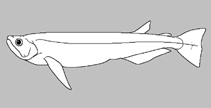| Family Cynodontidae - Dogtooth characins | ||||
| Order | : | Characiformes |

|
|
| Class | : | Teleostei | ||
| No. in FishBase | : | Genera : 3 | Species : 8 Eschmeyer's Catalog of Fishes | ||
| Environment | : | Fresh : Yes | Brackish : Yes | Marine : No | ||
| Division | : | Primary freshwater | ||
| Aquarium | : | some | ||
| First Fossil Record | : | |||
| Remark | : | Fishes of the family Cynodontidae comprise a group of very distinctive Neotropical characiforms easily recognizable by their oblique mouth, well developed dentary canines, and relatively expanded pectoral fins. The group is not very diverse with 13 species currently recognized and grouped under two subfamilies: the Cynodontinae and the Roestinae (Lucena & Menezes, 1998). The Cynodontinae is represented by the largest members of the family with some of its species reaching up to 65 cm in length and possessing maximum development of dentary canines among cynodontids. The subfamily has been the subject of recent taxonomic and phylogenetic investigation by Toledo-Piza, (2000) and Toledo-Piza et al. (1999) with three genera being recognized: Cynodon with 3 species, hypothesized as the sister group to the monotypic Rhaphiodon, and this clade being the sister group to Hydrolycus with 4 species. The Roestinae includes species that reach a maximum length of 20 cm and are represented by Roestes with 3 species and Gilbertolus with two (Menezes & Lucena, 1998). The majority of cynodontid species occur in the Rio Amazonas and Río Orinoco basins, and in the rivers of the Atlantic slopes of the Guianas. Rhaphiodon vulpinus is the only Cynodontidae that ranges southward to the Paraná-Paraguay and Uruguay basins, and Gilbertolus occurs in the transandean drainages of the Río Atrato, Río Magdalena, and Lago Maracaibo basins of Colombia and Venezuela. Fossil cynodontids are represented by dentary canines originated in Miocene deposits from the La Venta fauna, located in the present Río Magdalena valley of Western Colombia, in the Anta Formation at Quebrada de la Yesera, Salta, and near the city of Paraná, Entre Ríos the latter two localities in Argentina (Lundberg, 1997; Cione & Casciotta, 1995, 1997). Most of what is known about the habits and biology of the Cynodontidae refers to members of the Cynodontinae. They live in mid- and surface waters of rivers, lakes, and flooded forests in all water types, are predatory fishes, mainly piscivorous, using their dentary canines to stab prey (Arendt 1997; Goulding, 1980). Although not much valued as food, some species may have some importance in subsistence commercial fisheries (Mendes dos Santos et al., 1984; and Taphorn, 1992). Hydrolycus is a sport species having been recently added to the International Game Fish Association in the fly and rod class (International Game Fish Association, 1995). The ecology of roestine species is poorly known. They are also much less common in museum collections when compared to cynodontines. Suggested new common name for this family from Ref. 58418. | ||
| Etymology | : | Greek, kyon, -onos = dog + Greek, odous = teeth ( Ref. 45335). | ||
| Reproductive guild | : | nonguarders | ||
| Typical activity level | : | |||
Main Ref. |
: | Nelson, J.S. 1994 | ||
| Coordinator | : | Nelson, J.S. 1994 | ||
Deep Fin Classification

|
: | Osteichthyes | Actinopterygii | Actinopteri | Neopterygii | Teleostei | Osteoglossocephalai | Clupeocephala | Otomorpha | Ostariophysi | | Otophysa | | | | | | Characiphysae | Characiformes | Characoidei | | Cynodontidae | ||
Important recommendation:
The list below must not be used as an authority reference synonymy list like those found in scientific published revisions, which must be the source to be used and cited eventually when they exist.
Rather, it reflects the current content of FishBase, and the progress with respect to synchronization with the Catalog of Fishes. However, we think it can be useful for users to assess the quality of information in FishBase, to start new work on the family, or to cross-check with other lists.
But we appreciate to be cited in publications when this list has been of any working value. In particular, for published scientific, we suggest then to cite it in the Material and Method section as a useful tool to conduct the research, but again, not as a taxonomic or nomenclatural authority reference.
Unless it is explicitly precised, the list is not complete, please search all original names published for the family in the Catalog of Fishes (genera, species), including those with uncertain or unknown status, that are not included in FishBase when they are not attached to a valid species.
This list uses some data from Catalog of Fishes (not shown but used to sort names).
The list ordered as follows:
Please send comments and corrections if you detect errors or missing names.
| Scientifc name | Status | Senior/Junior synonym | Combination |
|---|---|---|---|
Cynodon gibbus (Agassiz, 1829) | accepted | senior | new |
Rhaphiodon gibbus Agassiz, 1829 | synonym | senior | original |
Cynodon meionactis Géry, Le Bail & Keith, 1999 | accepted | senior | original |
Cynodon gibbus (non Spix & Agassiz, 1829) | misapplied | misapplied | new |
Cynodon septenarius Toledo-Piza, 2000 | accepted | senior | original |
Rhaphiodon vulpinus Spix & Agassiz, 1829 | accepted | senior | original |
Rhaphiodontichthys vulpinus (Spix & Agassiz, 1829) | synonym | senior | new |
! Raphiodon vulpinus Spix & Agassiz, 1829 | synonym | senior | original |
Hydropardus rapax Reinhardt, 1851 | synonym | junior | original |
Salmo tamuco Kner, 1860 | ambiguous | questionable | original |
Hydrolycus scomberoides (Cuvier, 1819) | accepted | senior | new |
Hydrocyon scomberoides Cuvier, 1819 | synonym | junior | original |
! Hydrolicus scomberoides (Cuvier, 1819) | synonym | senior | new |
Hydrocynus scomberoides Cuvier, 1816 | ambiguous | other | original |
Cynodon pectoralis Günther, 1866 | synonym | junior | original |
Hydrolycus pectoralis (Günther, 1866) | synonym | junior | new |
Hydrolycus armatus (Jardine, 1841) | accepted | senior | new |
Hydrocyon armatus Jardine, 1841 | synonym | senior | original |
Hydrolycus tatauaia Toledo-Piza, Menezes & Santos, 1999 | accepted | senior | original |
Hydrolycus wallacei Toledo-Piza, Menezes & Santos, 1999 | accepted | senior | original |